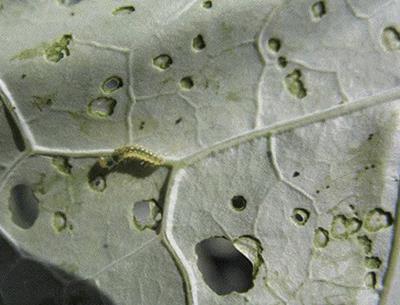We’re just about to hit fall décor season, and cabbage and kale are seasonal favorites of garden shoppers. However, growers face a couple of pests that attack these crops that could them unsellable. Nick has some tips below, and Josh put together a short video you can share with your team to get everyone on the same page regarding cabbageworms and cabbage loopers.
PROBLEM: If you see chunks missing from your ornamental cabbage and kale crops, it could be from white butterfly-like moths that fly around during the day (cabbageworm moths, Pieris rapae). Cabbage loopers (Trichoplusia ni) could also be the culprits.

NICK’S TIP: Properly identifying your pest is a critical component of IPM, and though management of these pests is basically the same, it’s important to know how to identify them both before populations get out of hand and they do major damage to your crop.
Cabbageworm moth adults (sometimes called “cabbage whites”) are white or pale yellow in color, are active during the day, and fold their wings up along their backs. Larvae are green in color, slightly fuzzy, about 1 1/4 in. long, and are generally very slow-moving. Their eggs are yellowish in color and can be found on both the underside and top of leaves.
Cabbage looper adults are much less showy compared to cabbageworm moths and are generally mottled brown and gray in color. Adults are nocturnal (so seeing them during the day is unlikely), and they fold their wings across their backs. Larvae are light green with several, subtle white lines running along their sides, and can move rather quickly for their size (about 1 1/2 in. long at mature size). Eggs are white in color and are typically found on the undersides of leaves, tucked in alongside the midrib or prominent leaf veins.
The longer you wait to manage these pests, the more damage they will do. In a couple of days, if left unchecked, a few mature looper or cabbageworm larvae can render a once-beautiful cabbage/kale crop completely unsalable.
It's critical to control them immediately, once they have been identified in your production area. Adults are the earliest warning sign that an outbreak may occur, but they do not actually feed on plants, so controlling them is not the most productive management strategy.
The most effective way to control these moth larvae is by applying a Spinosad-based insecticide or a product containing Bacillus thuringiensis (Bt), but other active ingredients like pyrethrin and neem are also effective. Repeat applications will likely be necessary over the life of your crop, so a rotation between Spinosad, Bt, and another agent is suggested to achieve robust control.
Watch Josh’s brief video below to drive home these technical tips.